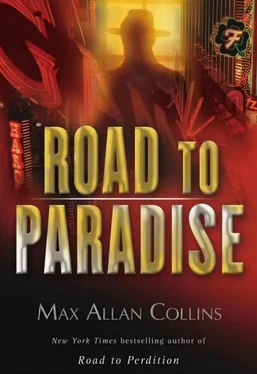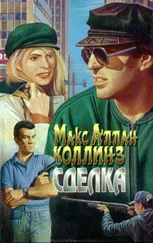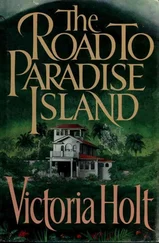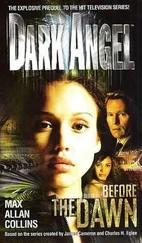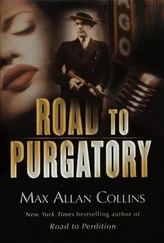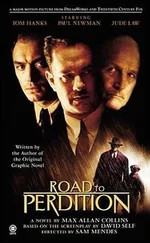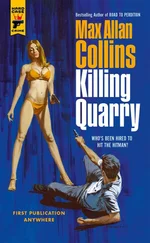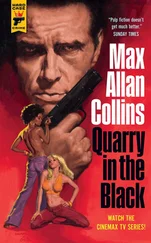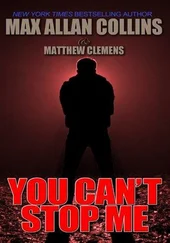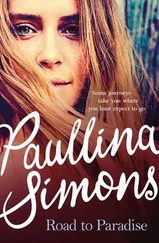The boy dropped to his knees. Hung his head. He was crying.
“Forgive me,” Antonio said. “Forgive me.”
Michael put his hand on the boy’s shoulder; then he knelt beside him.
“Only God can do that, son.”
“I’m sorry... I’m sorry... God forgive me.”
“He will,” Michael said. “Pray to Him... right now, pray to Him. And ask. Just ask.”
Antonio snuffled snot and nodded, black locks of hair shimmering in the dim light, and clasped his hands and began to pray, silently, while Michael squeezed the boy’s shoulder, his own head bowed, too.
Knowing that this time, finally, he’d made the right choice.
This novel follows Road to Purgatory (2004), the prose sequel to my graphic novel Road to Perdition (1998), on which the Sam Mendes film of 2002 was based, starring Tom Hanks, Paul Newman, Jude Law, Tyler Hoechlin, and Stanley Tucci. To coincide with the release of that film, I also wrote a novel version of Road to Perdition based on my original work as illustrated by Richard Piers Rayner (and David Self’s screenplay adaptation); the book was originally published in severely truncated form, but I’m pleased to say the full text is now available from Brash Books, making the entire prose trilogy available.
A second graphic novel, Road to Perdition 2: On the Road (2004), indicates my continuing interest in these characters, and the O’Sullivan family saga as it intertwines with organized crime in twentieth-century America, as does the graphic novel coda, Return to Perdition , published in (2012).
Despite extensive speculation, supposition, and fabrication, this novel does have a basis in history. Many real-life figures appear under their own names, including crime figures Sam Giancana, Tony Accardo, and Sam DeStefano. Other characters are either wholly fictional — despite his real uncle, Little Sam DeStefano is an imagined character, as is Marshal Donald Hughes — or fictional ones with real-life counterparts, such as lawyer Sidney Horshak and WITSEC associate director Harold Shore.
The major liberty taken here is time compression, with events that took place between April 1973 and June 1975 telescoped into a few months. As much as I pride myself on accuracy, the play remains the thing, and I make no apology for the “1973” of this novel containing elements of all three years, including pop culture and sociological references.
My first two novels, written while I was still attending the Writers Workshop at the University of Iowa, were published in 1973; they had to do with a fifty-year-old bank robber on the run from his former mob bosses (so much for progress). Having written twenty-five or more historical crime novels, I found it sobering to be writing “historical” fiction set within my own career; also, had I known I’d be writing about the mid-’70s, I’d have paid more attention. Among the works that helped refresh my memory were the extensive booklet included with Have a Nice Decade: The ’70s Pop Culture Box (Rhino Records); Stuck in the Seventies (1995), Scott Matthews, Jay Kerness, Tamara Nikuradse, Jay Steele, and Greg White; and Rolling Stone: The Seventies (1998), edited by Ashley Kahn, Holly George-Warren, and Shawn Dahl. Homes depicted herein were influenced by the massive, lavishly illustrated (and dead serious) The House Book (1974), Terence Conran, and the hysterically funny Interior Desecrations (2004), James Lileks.
Joining in this effort in reluctant nostalgia was my longtime research partner, George Hagenauer. George focused on Chicago crime, as usual, and was especially helpful on the Witness Protection Program, leading me to two key books: The Alias Program (1977), Fred Graham, and WITSEC: Inside the Federal Witness Protection Program (2002), Peter Earley and Gerald Shur (WITSEC founder). I also consulted On the Run: A Mafia Childhood (2004), Gregg and Gina Hill.
Cal-Neva is of course a real casino and resort, and the back-story comes from research, though Michael Satariano’s tenure is heavily fictionalized and is in no way meant to negatively reflect on this landmark slice of Americana, still going strong. Books consulted on Cal-Neva and Lake Tahoe included, Tales of Tahoe (1969), David J. Stollery, Jr.; Wood Chips to Game Chips: Casinos and People at North Lake Tahoe (1985; 1999), Bethel Holmes Van Tassel; and The Last Good Time (2003), Jonathan Van Meter, the story of Skinny D’Amato, who ran gambling at Cal-Neva in the Sinatra ’60s.
Although Frank Sinatra is not an on-stage character in this novel, his stormy history with Cal-Neva made it inevitable that much about the resort would be found in such books as: All or Nothing at All: A Life of Frank Sinatra (1997), Donald Clarke; Frank Sinatra: My Father (1985), Nancy Sinatra; His Way: The Unauthorized Biography of Frank Sinatra (1986), Kitty Kelley; Mr. S: My Life with Frank Sinatra (2003), George Jacobs and William Stadiem; and Rat Pack Confidential (1998), Shawn Levy. I thank all of these authors, and apologize to Nancy for listing her with Kitty.
Though the John Looney aspect of this novel is minor compared to the previous Road trips, I would again like to acknowledge Rock Island historian BJ Elsner for both her invaluable book Rock Island: Yesterday, Today & Tomorrow (1988), and her friendship. Also, my CSI associate Matthew V. Clemens helped me on Vegas questions.
Several books by the late FBI agent William F. Roemer, Jr., were key, including Accardo: The Genuine Godfather (1995); The Enforcer — Spilotro: The Chicago Mob’s Man Over Las Vegas (1994); and Roemer: Man Against the Mob (1989).
Gus Russo’s The Outfit (2001) is an excellent, detailed overview of the Chicago mob, and helped bring me out of the Capone/Nitti years, with which I’m so familiar, into the latter half of the twentieth century. The best book on Sam Giancana remains The Don: The Life and Death of Sam Giancana (1977), William Brashler, and I’m indebted. But helpful, too, were Double Cross (1992), Sam and Chuck Giancana, and Mafia Princess: Growing Up in Sam Giancana’s Family (1984), Antoinette Giancana and Thomas C. Renner. Richard Lindberg’s Return to the Scene of the Crime (1999) and Return Again to the Scene of the Crime (1999) are essential Chicago illustrated criminal histories, the Giancana and DeStefano entries critical to this novel. Key to understanding the interworkings of the mob-influenced gambling business was Casino: Love and Honor in Las Vegas (1995), Nicolas Pileggi. Other useful organized-crime books included The Last Mafioso (1981), Ovid DeMaris, and The Mafia Encyclopedia (1987), Carl Sifakis.
Chicago references consulted included Chicago on Foot: Walking Tours of Chicago’s Architecture (1977), Ira J. Bach, and Architecture 3: Frank Lloyd Wright (1998), Robert McCarter (Unity Temple section only). The updated ’60s and ’70s editions of the WPA guides for California, Arizona, and Illinois were also helpful, as was the picture book Arizona (1978), David Muench and Barry Goldwater.
The handling of notification of an MIA during Vietnam was derived chiefly from the excellent Vietnam: Angel of Death (2002), Harry Spiller.
Various Internet sites provided vintage Tahoe photographs and details on criminals, geography, Vietnam, buildings, school colors, the 1970s, and even Sam Giancana’s final recipe; thank you to scores of cyber scholars and enthusiasts.
I would like especially to thank and acknowledge my editor, Sarah Durand, not just for her intelligent and helpful editing, but her understanding and support when real life intruded on the writing of this book. Also, I would again like to thank Trish Lande Grader, who saw potential in my proposal for prose sequels to Road to Perdition .
Читать дальше
